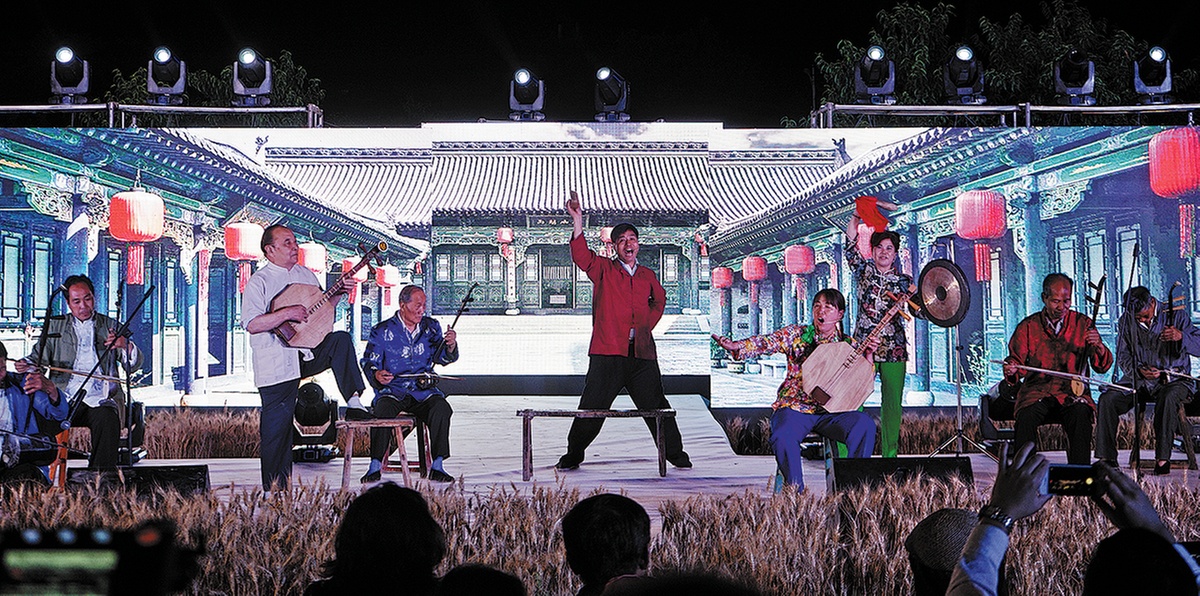
Farmers stage a Qinqiang Opera performance in the outdoor theater at Caijiapo village in Xi'an, Shaanxi province, during the Mangba Arts Festival in 2018. (Photo: China Daily)
When artist Wu Xiaochuan and his student Cui Kaimin searched the countryside outside Xi'an, capital of Shaanxi province, for a village with good views in May 2018, he did not plan to start a rural art festival, let alone one that would still be taking place three years later.
But earlier this month, students from the top eight Chinese fine arts academies arrived in Caijiapo village, 50 kilometers southwest of Xi'an, to take part in a residency program with the aim of creating original artworks in the foothills of the Qinling Mountains.
The program is part of the annual Mangba Arts Festival launched by Wu and Cui at Caijiapo in 2018. Mangba means "gathering in the fallow season" in the local dialect.
"What is art? Harvesting wheat is art," said Wu, director of the Xi'an Academy of Fine Arts' Experimental Art Department, recalling what Caijiapo residents said about their artwork earlier this year.
But three years ago, when he and Cui first visited the village in Huyi district on the southwestern outskirts of Xi'an, villagers had no idea what they wanted to do.
Cui, a young artist and teacher at the academy, said that he and Wu first rented about 4,000 square meters of wheat fields from farmers for their use.
"They didn't quite understand what we were doing. Four of our graduate students, all girls, had to get rid of weeds on their own while villagers just stood by," he said.
As the villagers and students spent more time together, residents came to understand what the aspiring artists were doing and occasionally gave them rice and snacks.
"Also, most of the residents are elderly. They're lonely and were happy to do something with the young people," Cui said.
When the one-month study session for the 40 experimental art students ended in June 2018, a large glass mirror was erected in a harvested wheat field and some old items, like small stools and hand fans were displayed in a well-crafted cabinet. The students used tracks made by hand drawn rack trucks, empty flour sacks, and even wheat straw, to make the connection between art and village life.
They launched the arts festival, which included a cornfield arts exhibition and a crop-themed arts project.
"Art is enchantment," Wu said. "Villagers here deserve a life of good taste."
Wu believes that in the past 30 years, social art research has become cutting-edge, allowing experimental art to explore its relationship with the mechanisms of Chinese society.
"The way of narrating a story in experimental art is to find a unique solution to the development of Chinese villages," he said. "We are not learning other country's art forms and ways of presentation, but are reconsidering and reconnecting with rural people, the land, and society."
Some changes have taken place in the village. By the summer of 2019, infrastructure had been improved, houses renovated and roadways widened.
A circular outdoor theater was also built in a large, abandoned fishpond. During the fallow season, usually from July to October, villagers used to rest and socialize and seldom went out. Now that many young villagers work elsewhere, however, few people get the chance to get together any more.
The theater brought all the villagers from Caijiapo together again.
The students put on shows and invited friends from other art academies in Xi'an to stage dramas. Some nights, villagers staged Qinqiang Opera, amazing the visitors with their beautiful voices.
"It was cool! We sat in the wheat field and listened to the villagers singing old opera," Wu said. "It was quite amazing. Then we started thinking about organizing a drama festival."
The drama festival became a part of the annual arts festival in 2019.
The Central Shaanxi Art Cooperative came into being. For the past three years, paintings and installations have been created during the festival to show the transformation of the rural environment.
"Turning daily life into art" is the way villagers understand the festival.
This year, besides grapes, kiwi fruit and wheat fields, the villagers themselves have become topics of murals created by the arts students. "When the villagers saw the murals, they felt proud to be part of Caijiapo and proud to show their village to more outsiders," Wu said. "Compared to traditional art, contemporary art has always been controversial. But in Caijiapo, whether it is making paintings on walls or installations in wheat fields, being controversial doesn't seem that important.
"After all, it's the people who live there that really matter."


